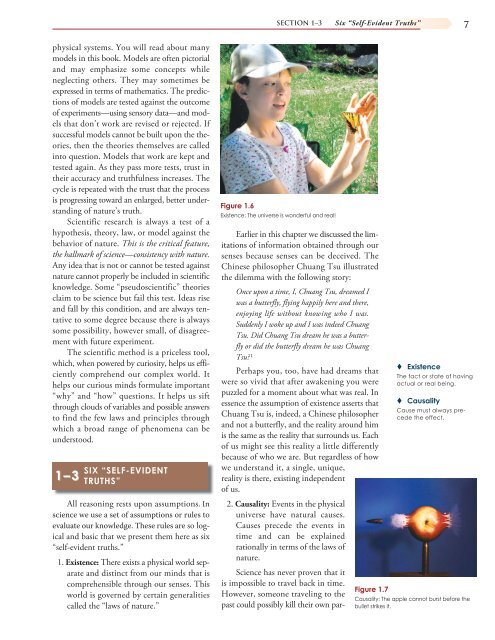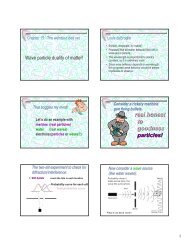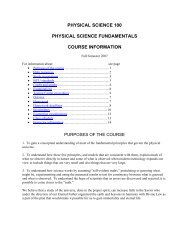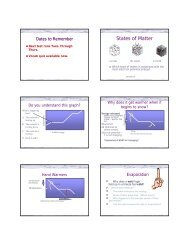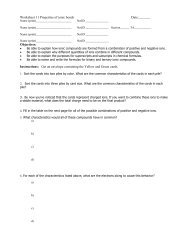knowledge, science, and the universe chapter 1 - Physical Science ...
knowledge, science, and the universe chapter 1 - Physical Science ...
knowledge, science, and the universe chapter 1 - Physical Science ...
Create successful ePaper yourself
Turn your PDF publications into a flip-book with our unique Google optimized e-Paper software.
SECTION 1–3 Six “Self-Evident Truths” 7<br />
physical systems. You will read about many<br />
models in this book. Models are often pictorial<br />
<strong>and</strong> may emphasize some concepts while<br />
neglecting o<strong>the</strong>rs. They may sometimes be<br />
expressed in terms of ma<strong>the</strong>matics. The predictions<br />
of models are tested against <strong>the</strong> outcome<br />
of experiments—using sensory data—<strong>and</strong> models<br />
that don’t work are revised or rejected. If<br />
successful models cannot be built upon <strong>the</strong> <strong>the</strong>ories,<br />
<strong>the</strong>n <strong>the</strong> <strong>the</strong>ories <strong>the</strong>mselves are called<br />
into question. Models that work are kept <strong>and</strong><br />
tested again. As <strong>the</strong>y pass more tests, trust in<br />
<strong>the</strong>ir accuracy <strong>and</strong> truthfulness increases. The<br />
cycle is repeated with <strong>the</strong> trust that <strong>the</strong> process<br />
is progressing toward an enlarged, better underst<strong>and</strong>ing<br />
of nature’s truth.<br />
Scientific research is always a test of a<br />
hypo<strong>the</strong>sis, <strong>the</strong>ory, law, or model against <strong>the</strong><br />
behavior of nature. This is <strong>the</strong> critical feature,<br />
<strong>the</strong> hallmark of <strong>science</strong>— consistency with nature.<br />
Any idea that is not or cannot be tested against<br />
nature cannot properly be included in scientific<br />
<strong>knowledge</strong>. Some “pseudoscientific” <strong>the</strong>ories<br />
claim to be <strong>science</strong> but fail this test. Ideas rise<br />
<strong>and</strong> fall by this condition, <strong>and</strong> are always tentative<br />
to some degree because <strong>the</strong>re is always<br />
some possibility, however small, of disagreement<br />
with future experiment.<br />
The scientific method is a priceless tool,<br />
which, when powered by curiosity, helps us efficiently<br />
comprehend our complex world. It<br />
helps our curious minds formulate important<br />
“why” <strong>and</strong> “how” questions. It helps us sift<br />
through clouds of variables <strong>and</strong> possible answers<br />
to find <strong>the</strong> few laws <strong>and</strong> principles through<br />
which a broad range of phenomena can be<br />
understood.<br />
1–3 SIx “SELf-EVIdENT<br />
TRuThS”<br />
All reasoning rests upon assumptions. In<br />
<strong>science</strong> we use a set of assumptions or rules to<br />
evaluate our <strong>knowledge</strong>. These rules are so logical<br />
<strong>and</strong> basic that we present <strong>the</strong>m here as six<br />
“self- evident truths.”<br />
1. Existence: There exists a physical world separate<br />
<strong>and</strong> distinct from our minds that is<br />
comprehensible through our senses. This<br />
world is governed by certain generalities<br />
called <strong>the</strong> “laws of nature.”<br />
figure 1.6<br />
Existence: The <strong>universe</strong> is wonderful <strong>and</strong> real!<br />
Earlier in this <strong>chapter</strong> we discussed <strong>the</strong> limitations<br />
of information obtained through our<br />
senses because senses can be deceived. The<br />
Chinese philosopher Chuang Tsu illustrated<br />
<strong>the</strong> dilemma with <strong>the</strong> following story:<br />
Once upon a time, I, Chuang Tsu, dreamed I<br />
was a butterfly, flying happily here <strong>and</strong> <strong>the</strong>re,<br />
enjoying life without knowing who I was.<br />
Suddenly I woke up <strong>and</strong> I was indeed Chuang<br />
Tsu. Did Chuang Tsu dream he was a butterfly<br />
or did <strong>the</strong> butterfly dream he was Chuang<br />
Tsu 1<br />
Perhaps you, too, have had dreams that<br />
were so vivid that after awakening you were<br />
puzzled for a moment about what was real. In<br />
essence <strong>the</strong> assumption of existence asserts that<br />
Chuang Tsu is, indeed, a Chinese philosopher<br />
<strong>and</strong> not a butterfly, <strong>and</strong> <strong>the</strong> reality around him<br />
is <strong>the</strong> same as <strong>the</strong> reality that surrounds us. Each<br />
of us might see this reality a little differently<br />
because of who we are. But regardless of how<br />
we underst<strong>and</strong> it, a single, unique,<br />
reality is <strong>the</strong>re, existing independent<br />
of us.<br />
2. Causality: Events in <strong>the</strong> physical<br />
<strong>universe</strong> have natural causes.<br />
Causes precede <strong>the</strong> events in<br />
time <strong>and</strong> can be explained<br />
rationally in terms of <strong>the</strong> laws of<br />
nature.<br />
<strong>Science</strong> has never proven that it<br />
is impos sible to travel back in time.<br />
However, someone traveling to <strong>the</strong><br />
past could possibly kill <strong>the</strong>ir own par-<br />
Existence<br />
The fact or state of having<br />
actual or real being.<br />
Causality<br />
Cause must always precede<br />
<strong>the</strong> effect.<br />
figure 1.7<br />
Causality: The apple cannot burst before <strong>the</strong><br />
bullet strikes it.


